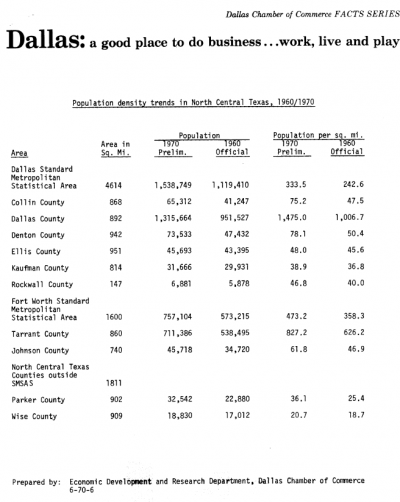
Economic Development and Research Department, Dallas Chamber of Commerce, June 6 1970. Dallas Chamber of Commerce Facts Series. Lester Strother Collection (AR0327), University of North Texas Special Collections.
The collections being exposed within the Southwest Metroplex blog all share the chaos and excitement that overcame the Dallas-Fort Worth area in the decades following World War II. UNT’s Special Collections department houses items documenting the enormous population boom in North Texas, tremendous strides made in transportation and urban planning, political environments, and a booming economy. We use the items in these collections in an attempt to understand the past, but also to understand the future. According to some, our future may be as the northern tip of a “Texas Triangle,” a plan that foresees the four largest areas in the state (DFW, Houston, Austin, and San Antonio) growing closer together.
Although the idea of a Texas Triangle sounds like a nauseating string of suburbs connecting the state’s urban areas, goals for the Triangle revolve around long-term sustainability in all senses of the word–cultural, economical, and environmental. Farmland would not be put to waste by constructing acres and acres of subdivisions; instead, it would be used to raise food that would only be distributed locally. Historic buildings would not be demolished; they would be preserved or re-envisioned to play a useful role in society. Businesses in North Texas would work with those in the rest of the state, which may result in even more economic prosperity.
Proponents of the megaregion idea point to growing population and economic success in recent years, as well as predictions for future growth. 70% of Texans currently live in one of these four areas, and population in the Triangle region is expected to increase by 65% in the next forty years–an additional 10 million people. If these cities were to work together with a megaregional scale in mind, many believe the effects of economic and natural disasters would be lessened. Room could also be made for experiments in areas like transportation, education, sustainable agriculture, and urban redevelopment.
High-speed rails like these may be the first step in the development of the Texas Triangle, but other plans will likely be slow to come, if they ever arrive at all. However Texas changes in the next fifty or one-hundred years, future scholars will surely be intrigued by this idea for a Texas megaregion. For more information on the Texas Triangle, visit texastriangle.org and America2050.org. Materials found in the Texas Metro Magazine collection, Model Cities Program collection, and North Central Texas Council of Governments collection contain valuable information about how the Dallas-Fort Worth area became prosperous enough to anchor such a megaregion.
-by Alexandra Traxinger Schütz



Leave a Reply